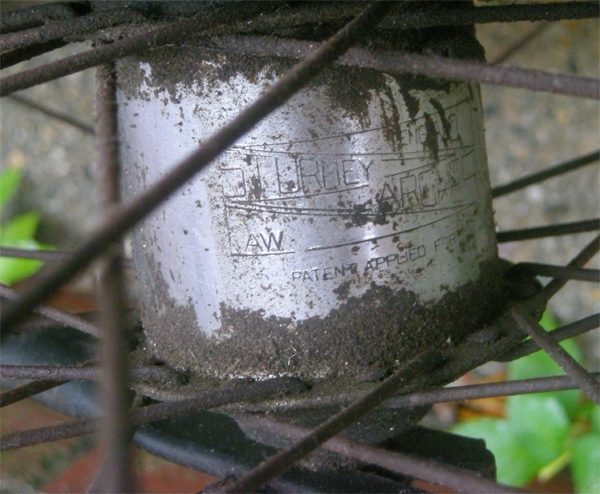 Sure, at first glance this is just another filthy Sturmey Archer hub. Those who know bicycles will see that it's an AW model, which identifies it as being from a vintage 3-speed. But look closer still. Anything unusual? If you have a good eye, you can see the words at the very bottom of the hub: "Patent applied for". Patent applied for? Why, this must be one of the earliest Sturmey Archer hubs ever made! What bicycle can it possibly belong to?
Sure, at first glance this is just another filthy Sturmey Archer hub. Those who know bicycles will see that it's an AW model, which identifies it as being from a vintage 3-speed. But look closer still. Anything unusual? If you have a good eye, you can see the words at the very bottom of the hub: "Patent applied for". Patent applied for? Why, this must be one of the earliest Sturmey Archer hubs ever made! What bicycle can it possibly belong to? Meet my "dirty little secret". She was given to me about a month and a half ago, but I kept quiet, because I am not yet certain what I will do with her. From a historical point of view, this is an amazing find: an early Raleigh Tourist in all original condition; year of production most likely 1936. This early Raleigh is the predecessor to the DL-1 Lady's Tourist I so love, but there are some notable differences between them. This early bicycle has a geometry that I find somewhat puzzling: The seat tube is quite long (almost the same size as on the 22" DL-1), but the wheelbase is extremely short, making for a crowded "cockpit" with very little room between the saddle and the handlebars. This makes the bicycle seem much too small for me, even though the saddle height is just right for my size. I would love to know the reasoning behind this construction.
Meet my "dirty little secret". She was given to me about a month and a half ago, but I kept quiet, because I am not yet certain what I will do with her. From a historical point of view, this is an amazing find: an early Raleigh Tourist in all original condition; year of production most likely 1936. This early Raleigh is the predecessor to the DL-1 Lady's Tourist I so love, but there are some notable differences between them. This early bicycle has a geometry that I find somewhat puzzling: The seat tube is quite long (almost the same size as on the 22" DL-1), but the wheelbase is extremely short, making for a crowded "cockpit" with very little room between the saddle and the handlebars. This makes the bicycle seem much too small for me, even though the saddle height is just right for my size. I would love to know the reasoning behind this construction.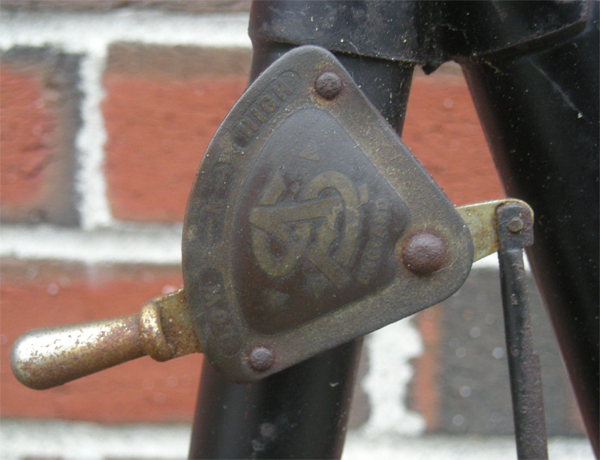 A very early Sturmey Archer 3-speed quadrant shifter. This preceded the trigger shifter that we are used to seeing on the handlebars of vintage 3-speeds. On diamond frame bicycles, the quadrant shifter was mounted on the top tube. On this bicycle it is mounted at the very top of the "loop" tube. Aside from some fading due to age, this beautiful shifter is in perfectly preserved condition. The whole bicycle, in fact, seems to be frozen in its original state, save for a coat of surface rust. The rod brakes are attached via braze-ons on the inside of the fork (as opposed to clipped on, as became the standard on later models) and function extremely well. The chrome on the handlebars and rod levers is in excellent condition.
A very early Sturmey Archer 3-speed quadrant shifter. This preceded the trigger shifter that we are used to seeing on the handlebars of vintage 3-speeds. On diamond frame bicycles, the quadrant shifter was mounted on the top tube. On this bicycle it is mounted at the very top of the "loop" tube. Aside from some fading due to age, this beautiful shifter is in perfectly preserved condition. The whole bicycle, in fact, seems to be frozen in its original state, save for a coat of surface rust. The rod brakes are attached via braze-ons on the inside of the fork (as opposed to clipped on, as became the standard on later models) and function extremely well. The chrome on the handlebars and rod levers is in excellent condition.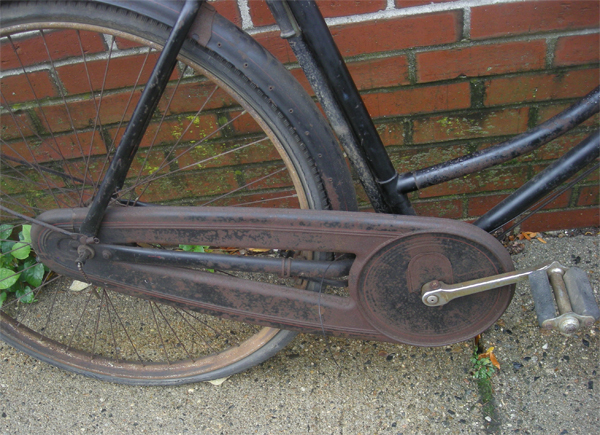 The original chaincase is entirely intact and dent-free. Notice also the holes drilled for skirtguards in the rear fender! I wonder what sort of guards this bicycle had when it was being ridden 70+ years ago.
The original chaincase is entirely intact and dent-free. Notice also the holes drilled for skirtguards in the rear fender! I wonder what sort of guards this bicycle had when it was being ridden 70+ years ago.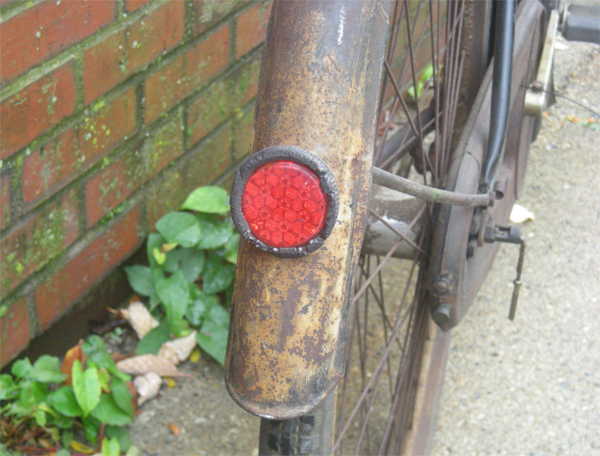 The rear reflector is glass, not plastic.
The rear reflector is glass, not plastic.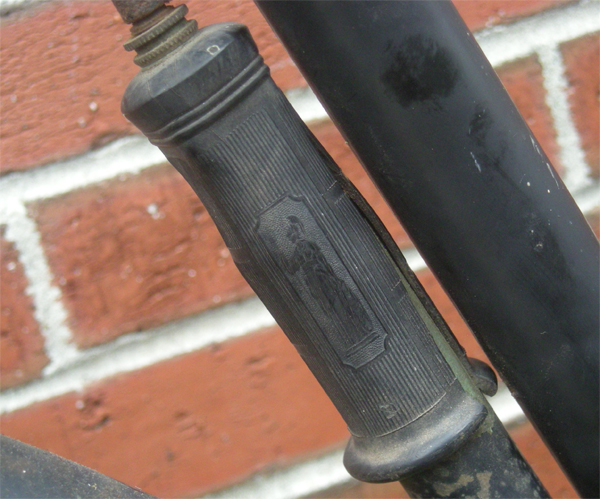 And I believe the pump is original as well, though the handle has split open. It is engraved with a Greek-themed motif. Aside from the split pump, other aspects of the bicycle that are damaged beyond repair are the melted rubber grips (see first picture) and the cracked tires. The wheels themselves look extremely rusty, but some have suggested that they might be salvageable by a soaking in an oxalic acid bath.
And I believe the pump is original as well, though the handle has split open. It is engraved with a Greek-themed motif. Aside from the split pump, other aspects of the bicycle that are damaged beyond repair are the melted rubber grips (see first picture) and the cracked tires. The wheels themselves look extremely rusty, but some have suggested that they might be salvageable by a soaking in an oxalic acid bath.
The bottom line however, is that I am at a loss about this bicycle. Under the circumstances in which it was given to me, it was pretty much impossible not to take it. But I have no idea what to do with it! Even in its present state, I could probably sell it and make a bit of money, but the thought of doing that makes me sad. I could restore it and probably make quite a bit of money, but that's sad as well. Plus it looks like I will be having a very busy winter, and restoration projects might prove impossible with everything else I already have on my plate. Perhaps I should look into donating it to a museum? In the meantime, this 1930's beauty is being kindly housed by Open Bicycle. For anybody local who is interested, the bike is available for public display (but it is not for sale). Ideas for what to do with it are most welcome. Perhaps it would make a good winter bike? (I kid, I kid!)
skip to main |
skip to sidebar
Blog Archive
-
▼
2009
(1637)
-
▼
December
(186)
- Bicycle Snow Cover!
- The Fox-Cable Wars -- Sports Fans' Woes
- Why Movies Suck
- New SI.com Column on Mike Leach and Texas Tech Leg...
- Texas Tech coach fired: Updated and moved to top
- Letter from a Parent
- Chance Encounters and Boston Vintage Bikes
- The NFL's Brief in American Needle v. NFL
- Ryck
- Warren Buffett vs. Index Funds
- Reilly gets a makeover
- The Aroldis Chapman Sports Law Saga Continues
- The Earthquake vs. Weather Trick
- The "Consistent With" Fallacy: How Not to Compare ...
- Texas Tech coach suspended--some questions
- Making hay while the sun shines ...
- Five Rivendell Fork Crowns
- Feeling Slow? A Simple Explanation
- LCCJ-pass
- Why You Should Eat at Chick-fil-a
- Multitasking is Bullshit
- The Days Ahead
- Enya - 'TF Celtic Moon' - Registered ISH Filly
- Random Thoughts on Various Subjects
- Books vs. Movies
- Why Xmas Sux
- Torsdag fredag
- DVD-Blood Simple
- Owls, Bears, Bicycles
- Happy Holidays!
- The Rules Regarding Blood That May Put Mayweath...
- 3000 - Part 1
- Penitence house
- Pachauri Responds
- von Storch in the WSJ
- Instant replay and standards of review
- Saffy at 20 months
- Myron Rolle: The Student Athlete
- Peer Review in the IPCC
- Simplicity is best.
- Riding in a Winter Wonderland
- My Last Post for 2009
- Year in review
- Some news and another late run ...
- The Meaning of the 12 Days of Christmas
- How Large is the Global Energy Economy?
- Seminar Abroad 2010: Delegation Roster
- 9 Miscellaneous Tips
- Ricky sings to Elmo
- Hello Winter! Commuting in a Blizzard
- Does the IPCC Chairman Have Conflicts of Interest?
- Shawn Crawford - Humility
- Treating Peer Review Like a Partisan Blog
- City of San Francisco Threatens to Sue MLB
- Post-Copenhagen: More Questions than Answers
- Zen Habits Revisited
- Can Cricket Umpires be Bought?
- The Best Laid Plans
- Seminar Abroad 2010: FIFA World Cup/South Africa
- PZ Myers is a Dickhead
- Lost Trust
- American Needle Updates
- Before and After Copenhagen
- Michael Mann on the "Poor Judgment" of His Colleagues
- Happy Holidays!
- Arn Tellem on NCAA Ban on Use of Attorneys during ...
- Hey Telfer, get the chip off your shoulder
- Character Builds Coaching Clinic
- The Next NCAA President?
- More Wisdom on Activist Climate Science
- New Sports Law Scholarship
- The Paper that the Australian Government Didn't Wa...
- Wrapped in Science
- Was there any doubt?
- Dirty Little Secret
- Tender Deadline and Additional Free Agents
- Wrestler receives NCAA Sportsmanship Award
- Why It Is Better To Be Known As a Scoundrel
- Sarewitz and Thernstrom on the CRU Emails
- Catch 22
- Did Aroldis Chapman switch agents because of Torti...
- Thank you Dunstan - You have made my Year!!
- High Wheel in Somerville
- Illegal Motion?
- Stewart Brand's Four Camps
- Steps to Meet Japan's 25% Emissions Reduction Target
- Antique Fetish
- Virtuous Twist to a Birthday Party
- Stötar & en artikel
- Shellenberger and Nordhaus on Copenhagen
- Clive Crook on Climate Science and Public Trust
- The Halberg Awards
- Meg the Megastar is back!
- Atheism Is a Boring Subject
- Requested Correction in Daily Mail Article
- Two Photo Blogs Today
- Utah's Attorney General Planning an Antitrust Suit...
- A Brief Departure from Loveliness
- My Marvellous Megan
- Random Thoughts on Various Subjects
-
▼
December
(186)
Popular Posts
-
After a little over a week since 48 players exchanged numbers with their teams, and according to my research 13 players have signed if you i...
-
This is my opening post on my blog. This blog is going to be about the Media/ Sports/Music/Politicans. I hope ya'all find it interestin...
-
I am going ahead with the idea of facilitating barter exchanges between readers, chosing the old-school method in the interest of simplicit...
-
Male porn stars are famous for their above average endowments. Ron Jeremy is measured at 9.75 inches. Another famous porn star was John Holm...
-
I take what I call a journalistic interest in a variety of sports. If I didn't write, I wouldn't waste my time learning about them. ...
-
Paula Radcliffe is a distance runner who hails from Britain. She is the first woman to ever go below 2:20 for the marathon redefining what w...
-
Today's FT has a special report on Nigeria, and has a very interesting discussion of energy access : Despite average cash injections of...
-
Just wanted to thank everyone who has been apart, visited or entered our contests on this blog and help us get to 30,000. It's not quite...
Copyright © 2011 Sport News Update | Powered by Blogger
Design by Free WordPress Themes | Bloggerized by Lasantha - Premium Blogger Themes | Website Value Calculation Tool





0 comments:
Post a Comment